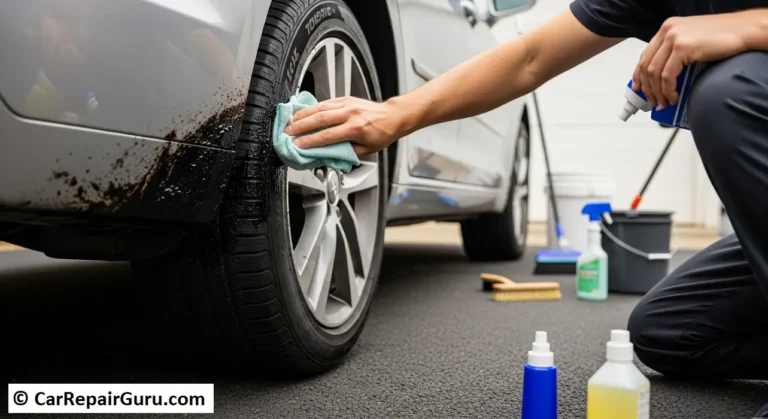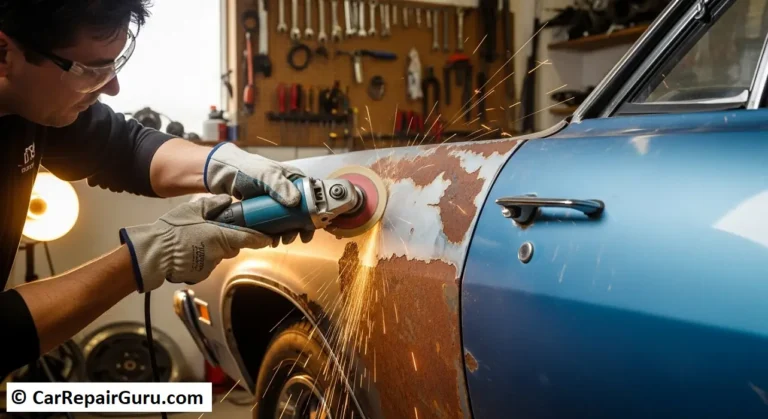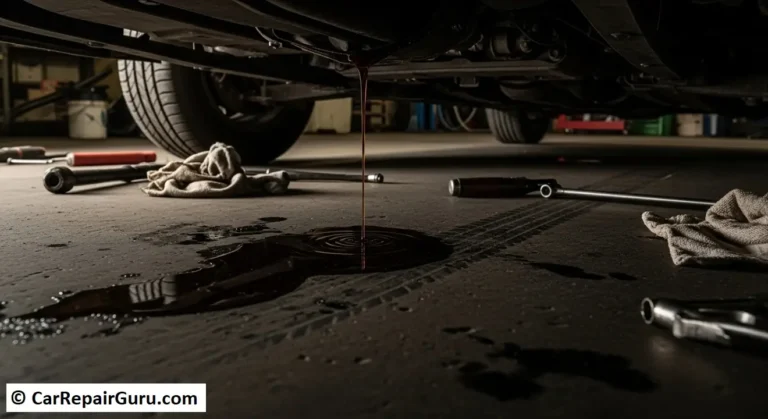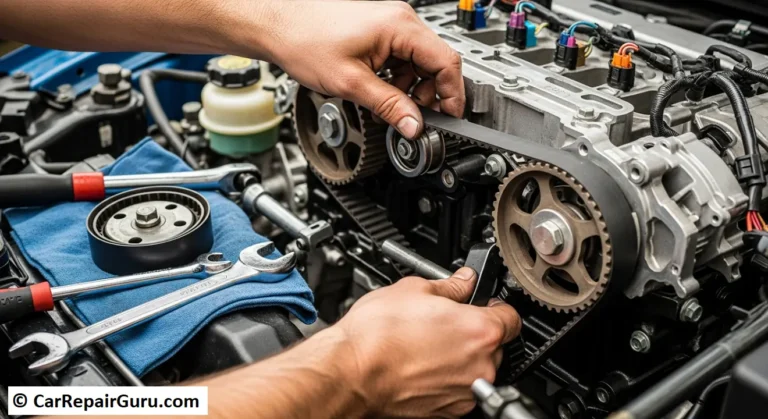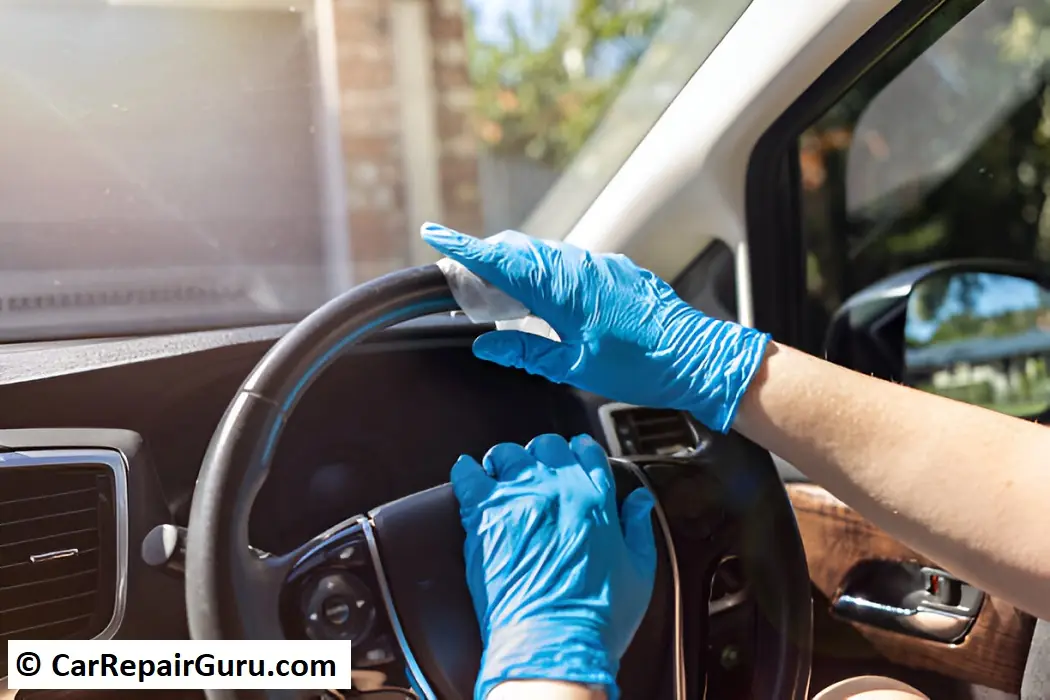
Keeping your car clean isn’t just about looks—it’s about care. A well-maintained car interior and exterior doesn’t just feel good; it protects your vehicle’s value and keeps everything running smoothly. Whether you’re a weekend warrior armed with a bucket and sponge or a DIY enthusiast ready to dive into detailing, having the right car cleaning tips can make all the difference.
From the dashboard to the engine bay, every part of your car deserves a little attention. Not sure where to start? Don’t worry. This guide covers everything you need to know—simple steps you can do at home, smart DIY car cleaning techniques, and even pro-approved car detailing tips that will keep your ride looking (and smelling) like new.
Ready to learn how to clean a car from top to bottom, inside and out? Let’s dive in and help you keep your vehicle spotless without breaking the bank—or your back.
1. Start with a Thorough Interior Declutter
Before you even think about scrubbing or vacuuming, the first step in any successful car cleaning session is a good old-fashioned declutter. Grab a trash bag and start removing everything that doesn’t belong—empty bottles, snack wrappers, receipts, and random items that have somehow taken up permanent residence. A clean interior starts with clearing the chaos.
One of the best car cleaning tips for staying organized is to use storage bins or organizers for essentials you want to keep in the car. Think phone chargers, napkins, and emergency kits. Cup holders? Try using silicone cupcake liners—they catch crumbs and are super easy to clean.
Once the larger items are out, slide your seats forward and check under and between them. You’ll be surprised what hides down there—coins, wrappers, maybe even that missing pen. This quick interior car cleaning step makes vacuuming more effective and gives you a clear view of what actually needs cleaning.
Decluttering may not be the flashiest part of the process, but it sets the stage for everything that follows. A tidy space is easier to clean and maintain—and just feels better every time you step inside your car.
2. Vacuuming: The First Step to a Clean Interior
Now that your car is decluttered, it’s time to tackle the dust, crumbs, and debris hiding in every corner. Vacuuming is one of the most effective car cleaning tips for creating a truly clean interior. It’s simple, doesn’t take long, and instantly makes your car feel fresher.
Start with the floor mats—remove them, shake them out, and vacuum both sides thoroughly. Then move on to the carpeting underneath. Use a vacuum cleaner for cars or a handheld vacuum with different attachments to get into tight spots like the edges of the seats, under pedals, and between seat cushions. If your vacuum has a crevice tool, even better—it’s perfect for those hard-to-reach areas.
Don’t forget the trunk. It’s often overlooked, but it collects dirt just like the rest of the interior. For fabric or carpeted surfaces, vacuuming will also help loosen up dirt before using any upholstery cleaning sprays later on.
Pro tip: use a soft brush attachment when vacuuming delicate surfaces like the dashboard or vents to avoid scratching. And if pet hair is a problem, try using a rubber squeegee or a lint roller after vacuuming to grab anything left behind.
Vacuuming might seem basic, but it’s the foundation of a clean car. It not only improves appearance—it helps eliminate odors and makes the rest of your DIY car cleaning routine far more effective.
3. Cleaning Dashboard and Console Areas
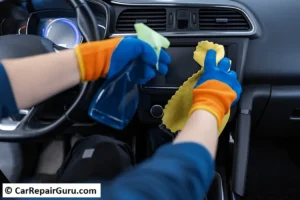
Once the floors are clean, it’s time to give your dashboard and console the attention they deserve. These areas collect dust, fingerprints, and grime faster than you might think—and they’re what you see every time you drive. One of the most overlooked car cleaning tips is to use the right materials: a microfiber cloth is your best friend here. It lifts dust without scratching surfaces or leaving behind lint.
For deeper cleaning, use a dashboard cleaner or a mild all-purpose interior spray. Spray it onto your cloth (not directly on the dashboard) to avoid getting product in air vents or electronics. Focus on the instrument panel, gear shift, center console, and cup holders—spots that tend to collect sticky residue and crumbs.
For tight corners and hard-to-reach spots, try using a soft detailing brush or even a toothbrush. Cotton swabs also work great for cleaning around buttons and in-between vents.
Cleaning the dashboard and center console regularly not only keeps your car looking sharp—it also improves hygiene. Dust and dirt can harbor allergens, so keeping these surfaces clean helps your car stay healthier, too.
This is a small detail that makes a huge difference. A clean dash makes the entire car feel newer and more comfortable.
4. Upholstery and Carpet Cleaning Techniques
Your car seats and carpets see a lot of action—spilled drinks, muddy shoes, pet hair, and everyday dirt. So when it comes to car cleaning tips, properly cleaning your upholstery and carpets is key to restoring that fresh, just-cleaned feel.
Start by vacuuming seats and floor areas thoroughly to remove surface debris. This helps prep the fabric for deeper cleaning. For fabric seats, use a foaming upholstery cleaner or a homemade mix of water and vinegar with a drop of dish soap. Spray lightly, scrub with a soft brush, and blot dry with a clean towel. Be careful not to soak the seats—you want to clean, not saturate.
Got leather seats? You’ll need a leather seat cleaner or a gentle leather-specific wipe. After cleaning, apply a conditioner to keep the leather supple and crack-free. It’s a small step that goes a long way in maintaining that premium look.
For carpet cleaning, start by sprinkling baking soda over the area and letting it sit for 15 minutes to absorb odors. Then use a carpet cleaner or steam cleaner for deeper stains. Always let carpets dry completely to prevent mildew.
Freshly cleaned upholstery instantly upgrades your car’s interior. It also helps eliminate hidden smells and allergens. Whether you’re tackling stains or just refreshing your ride, a good upholstery and carpet cleaning routine is one of the smartest DIY car cleaning habits you can build.
5. Window and Mirror Cleaning for Clear Visibility
Crystal-clear windows and mirrors aren’t just about aesthetics—they’re essential for safe driving. One of the most underrated car cleaning tips is giving proper attention to your vehicle’s glass surfaces, inside and out.
Start by choosing a streak-free glass cleaner (avoid household cleaners with ammonia, as they can damage window tint). Spray directly onto a microfiber cloth, not the glass, to prevent dripping into electronics or trim. Wipe in a circular motion, then finish with vertical or horizontal strokes for a clean, polished look.
Don’t forget the interior glass, which often gets coated with a hazy film from off-gassing materials. This film can seriously impact visibility at night or in bright sunlight. A second pass with a dry cloth helps remove any lingering streaks.
For side and rearview mirrors, use the same method but focus on the edges—dust and grime tend to settle there. And here’s a pro tip: roll windows down halfway to clean the top edges that usually get missed.
Clean glass not only looks great, but it also boosts safety. Combine this step with the rest of your DIY car cleaning routine, and your car will feel as sharp and clear as the day you drove it off the lot.
6. Exterior Wash: Techniques for a Spotless Finish

Washing your car’s exterior isn’t just about making it look good—it’s about protecting the paint and finish from damage caused by dirt, bugs, and road grime. When done right, this essential step in DIY car cleaning helps maintain your vehicle’s shine and resale value.
Start with a rinse to loosen surface dirt. Use a hose or pressure washer, starting from the top and working your way down. Then, grab two buckets—one with soapy water (use a car-specific shampoo) and one with clean water to rinse your mitt between swipes. This prevents dirt from scratching the paint.
Always use a microfiber wash mitt or soft sponge. Work in sections, and rinse each area before the soap dries to avoid water spots. Pay extra attention to bug splatter, bird droppings, and lower panels that collect the most grime.
After rinsing, dry the car using a microfiber towel or soft chamois. Letting it air dry can leave behind mineral deposits and streaks. For a glossy finish, follow up with a spray wax or sealant—it adds protection and that showroom shine.
And don’t forget the wheels and tires. Use a separate mitt and cleaner made for wheels to prevent brake dust from scratching the paint. A shiny set of tires adds the final touch.
Of all the car cleaning tips, mastering a proper wash is the most satisfying. Your car will not only look incredible but also stay protected for the long haul.
7. Tire and Wheel Cleaning Tips
Clean wheels and tires can instantly elevate your car’s appearance. They’re the finishing touch that takes your DIY car cleaning routine from good to great. And with the right approach, getting that deep black tire shine and spotless rims is easier than you think.
Start with a dedicated wheel and tire cleaner—avoid using your regular car shampoo here. Spray the product generously on cool wheels (never clean them when they’re hot), and let it sit for a minute to break down brake dust and road grime.
Use a separate tire brush or wheel mitt to scrub the surface, getting into the spokes and around lug nuts. For tight spaces, a soft detailing brush works wonders. Rinse thoroughly with water, making sure no cleaner residue is left behind.
Once dry, apply a tire dressing or gel. This not only gives your tires that rich, dark finish but also protects against cracking and fading caused by UV rays. Be sure to wipe off any excess product to avoid sling onto the body of the car when driving.
Out of all the car cleaning tips, paying attention to your tires and rims is a simple way to make your vehicle stand out. Clean wheels show you care—and they complete the polished, professional look.
8. Engine Bay Cleaning: Keeping It Neat
Many drivers skip cleaning the engine bay, but it’s one of the smartest car cleaning tips you can follow—especially if you plan to keep your car long-term or sell it. A tidy engine compartment makes it easier to spot leaks or worn components and keeps dust from affecting performance.
Start by making sure the engine is completely cool. Disconnect the battery terminals if you’re doing a deep clean. Cover sensitive components like the alternator, fuse box, and exposed wiring with plastic bags to protect them from moisture.
Use a degreaser or engine cleaner and spray it on lightly—don’t drench it. Let it sit for a few minutes, then scrub gently with a soft brush. Rinse carefully using low-pressure water or a damp cloth to avoid forcing moisture into electronics.
Dry the area with a microfiber towel or compressed air. For that final touch, apply a plastic or rubber conditioner to hoses and plastic covers. It restores shine and helps protect against cracking over time.
Though not a daily task, keeping your engine bay clean is a pro-level DIY car cleaning move. It shows you care about your vehicle inside and out—and it might even impress your mechanic.
9. Maintaining That New Car Smell

Nothing beats that fresh, new car scent—but keeping it around takes a little effort. One of the most appreciated car cleaning tips is focusing not just on looks, but also on how your car smells.
Start by keeping your interior clean. Regular vacuuming, wiping down surfaces, and tossing out trash prevent odors from building up. Deep-clean upholstery and carpets every few months—dirt and spills can create musty smells over time.
Use baking soda to absorb odors: sprinkle it on fabric surfaces, let it sit, then vacuum it up. For a long-lasting fresh scent, try charcoal air purifying bags or natural options like essential oil diffusers.
Be mindful of food and drinks in the car, and avoid smoking inside. And every now and then, leave the windows cracked open for airflow when parked in a safe spot.
A clean-smelling cabin completes the DIY car cleaning experience—making your ride as pleasant as it looks.
10. Regular Maintenance: Keeping Your Car Clean Longer
Consistency is key when it comes to car cleaning tips. Setting up a regular cleaning routine ensures that your car stays fresh and well-maintained. Aim to vacuum the interior and wipe down surfaces weekly, and give the car an exterior wash every two weeks. Regular upkeep prevents dirt buildup and minimizes the time needed for deep cleaning sessions.
Don’t forget about the engine bay and wheels—those can accumulate grime quickly if neglected. Even a quick touch-up once a month can keep your car looking sharp. Using protective coatings like wax on the exterior and a conditioning product for leather seats will help preserve that “new car” look for longer.
With consistent attention, your car will always look and feel well-maintained, making your cleaning efforts more manageable and rewarding in the long run.
Conclusion
Keeping your car clean is more than just an aesthetic choice—it’s a way to protect your investment and enjoy a comfortable, fresh driving experience. From simple car cleaning tips like regular vacuuming to more detailed techniques for upholstery and exterior care, maintaining a clean car is achievable for anyone willing to put in a little time and effort.
By following a regular cleaning schedule and using the right tools and products, you can extend the lifespan of your vehicle and enhance its value. And don’t forget—cleaning your car isn’t just about looks; it’s about keeping your car safe, functional, and comfortable for the long haul.
So, whether you’re tackling a quick clean or going for a full detailing, these tips will help keep your car looking its best, day after day.
FAQ
Q1: How often should I clean my car?
It’s recommended to clean your car every 1–2 weeks, especially if you use it frequently. However, cleaning your car’s interior more often is advisable to avoid dust buildup.
Q2: Can I use household cleaning products on my car?
While some household products can be useful for quick cleanups, it’s better to use car-specific cleaners for longer-lasting results. Household products may be too harsh on certain surfaces and could damage the car’s paint or upholstery.
Q3: What’s the best way to remove stains from car upholstery?
For fabric seats, use a steam cleaner or upholstery shampoo. For leather seats, use a leather cleaner or a specialized stain remover.
Q4: How can I prevent water spots after washing my car?
Avoid washing your car in direct sunlight. Dry the car immediately with a clean microfiber cloth after rinsing to prevent water spots from forming.
Q5: How do I clean my car’s engine without damaging it?
When cleaning your engine, use a degreaser and rinse gently with a low-pressure hose. Be sure to cover sensitive parts like the battery to avoid damage.

